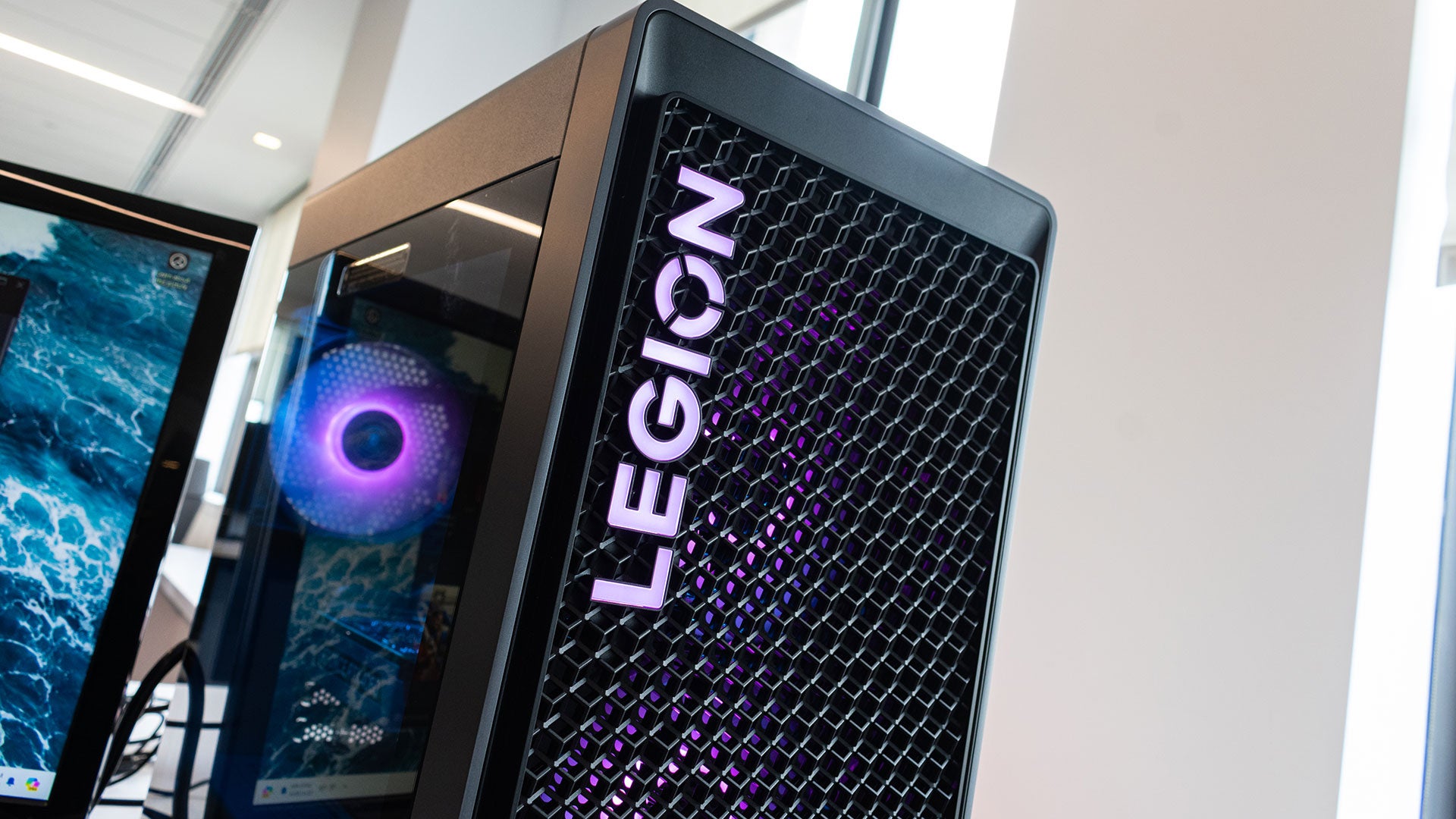The Lenovo Legion Tower 5i is an extremely boring gaming PC, but that’s not a bad thing necessarily. It’s a small-ish gaming tower, packed with entry-level hardware, but without any of the shiny extras that more expensive prebuilt gaming PCs, like the Legion Tower 7i, charge extra for. It’s just an Intel Core i5 processor, 16GB of RAM and an RTX 4060, and that’s all it really needs to be, especially at $1,000.
Lenovo does make up for some of that price by bundling an annoying antivirus software, but because you can just uninstall it, that’s not really a big deal. The Lenovo Legion Tower 5i is exactly what an entry-level gaming PC should be, and nothing more than that. And that is fine.
Design and Features
If you close your eyes and imagine a gaming PC, you’ll have an idea of what the Lenovo Legion Tower 5i looks like. It’s a black metal box with a glass side panel filled with PC components. The front of the case spices things up a bit by adding a unique honey-comb design that both looks cool and lets air flow more freely into the system, but beyond that, this is as simple as it comes.
The top of the tower has all of the front panel ports, netting you a headphone jack and two USB-A ports. This is a pretty standard array of ports, especially in a PC of this size, but it would have been nice to have one of the ports be USB-C. Luckily, the back of the system does include one USB-C connection, along with 6 other USB-A ports, an ethernet port, and the standard array of HDMI and 3 Display Port cables offered by the RTX 4060.
The tower is relatively small, measuring just 16.7 inches tall and 15.6 inches long. That is still big enough to upgrade to a more powerful graphics card later on, but keep in mind that you might have to upgrade the 500W power supply for higher-tier graphics cards.

You can open the system up by unscrewing the two thumb screws on the back of the glass side panel, which you can then lift off of the system. That’ll get you at most of the system, though the cables are routed behind the motherboard, which will require taking the metal cover off the other side of the computer to get at. This makes it extremely easy to make quick tweaks to the hardware, like swapping out your memory – which you’ll want to do at some point – or upgrading your SSD. Unlike some prebuilts these days, though, this is not a toolless entry – as much as I tried unscrewing the “thumb” screws securing the glass side panel with my hands, I needed to use a screwdriver. But that’s far from a dealbreaker.
Once I got into the system the first time, I took a look at the motherboard to make sure it was a standard-sized board, and it is! That means if something goes wrong or you want to upgrade to a new platform at some point, you can just swap the board out with a new one, without having to fork over the money for an entirely new system. Though, unlike its bigger sibling, the Legion Tower 7i, you get a bog-standard air cooler that looks like it came out of a Cracker Jack box, and the only lighting is a single white LED on the rear exhaust fan. But, again, this is an entry-level system, you can add pizazz later.
But because this is an entry-level system, it comes preloaded with a trial for McAfee antivirus, which was of course already expired by the time I opened the system up. So just a couple minutes after I got the system set up and running, the computer shoved a pop-up in my face telling me my trial was over and the system would explode or something if I didn’t enter my credit card information. I simply uninstalled the program and moved on, but I don’t love that computer manufacturers are still bundling this shady program with hardware in 2024.
There are good programs included however. Lenovo Vantage, for instance, will help you keep your system updated with current software, and will let you tweak your hardware settings. You can still do all of this stuff outside of this app if you have the technical info, but for someone that’s not familiar with Device Manager, it’s a godsend. Likewise, Lenovo Arena will gather all your PC games in one app, so you don’t have to bounce between Steam, Epic and the myriad other game launchers just to play your games. Still, totally optional and you can remove it if you don’t want it.

Performance
With an Nvidia RTX 4060 and an Intel Core i5 processor, the Lenovo Legion Tower 5i isn’t going to blow you away with max settings at 4K. Instead, this gaming PC shines at 1080p, where it’s still able to max out games with a decent frame rate.
In Cyberpunk 2077, the Tower 5i is able to deliver 64 fps at 1080p on the Ray Tracing Ultra preset at 1080p. Then, if you turn Frame Generation on – which you totally should – that performance number jumps to 99 fps. That’s not the best performance in the world by any means, but it’s about what I would expect for the hardware in this PC.
There are even a couple of games where it pushes into ‘high frame rate’ territory. For instance, in Assassin’s Creed Mirage, the Lenovo Tower 5i manages an impressive 98 fps average. Likewise, it can reach up to 84 fps in Total War: Warhammer 3.

Unfortunately, the Lenovo Legion Tower 5i does struggle a bit in Black Myth Wukong, which I tested using the ‘Cinematic’ preset. In that game, the gaming PC manages just 37 fps at 1080p, which puts it in the same territory as the Asus ROG NUC, albeit at a much lower price tag of $1,149, instead of $2,199.
That lower price tag makes the Lenovo Legion Tower 5i a much more compelling gaming PC, as it not only performs basically the same as the ROG NUC, but because it is using all standard-sized PC components, you can actually upgrade it as it gets older, rather than just watching it deteriorate over time.
Right out of the box, the Lenovo Legion Tower 5i isn’t a very exciting gaming PC. It’s using bog-standard hardware, including a lackluster CPU cooler that’s probably holding its processor back a little bit. But it still runs any game on the market right now, and because it’s so easy to open up and work on, you can keep it running for years, as long as you keep up with the upgrades.
Jackie Thomas is the Hardware and Buying Guides Editor at IGN and the PC components queen. You can follow her @Jackiecobra







